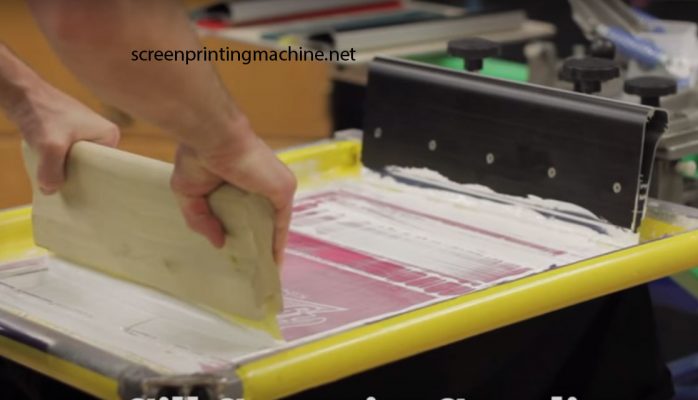The screen printing squeegee can significantly impact your printing; ensure you use the right one for the job.
Some screen printing squeegees are harder. Some feel softer. Why is that? Squeegees have different durometers. Durometers measure the hardness of the blades, and Specific print jobs require harder or softer blades. Let’s learn about the various durometers, their applications, and how to maintain them properly.
The right tools are essential for screen printing, and the squeegee is one of the most critical tools of screen printing equipment. Before purchasing a squeegee for your screen printing machine, consider some options. Moreover, it would be helpful to examine the effect of each option or variable on your print and then choose the best squeegee for your screen printing machine.

Examine the Shape:
You can find that the tip of the squeegee has several shapes. Those are as follows:
- Being with shaped Square or Straight-edge squeegee: The most frequently used squeegee blades are more suitable for standard screen printing work.
- Being with a shaped Round or ball-nose: Competent to print with the ink deposited heavily. As a result, it improves print quality on heavier substrates and prints more effectively using special ink.
- Usually, Round – or ball-nose squeegees are for printers that need a heavier deposit of ink, such as when printing on heavier substrates or with specialty inks.
- Beveled squeegees used for Printing curved or uneven substrates maintain a consistent quality on one or both sides of the blade.
Rigidity
The durometer measures squeegee rigidity, and a higher durometer refers to a more rigid blade. The harder squeegee blades shear the ink completely. On the other hand, a more substantial ink deposit is left behind by the softer squeegees.
The durometer range of soft squeegees is 50 to 60. These are suitable for printing on heavy substrates, controlling fibrillation, or using special inks without leaving a rich ink deposit.
Medium-hard squeegees are 70 durometer and suitable for screen printing machines to perform general screen printing jobs.
Hard or ultra-hard squeegees have a durometer of 80 to 90, leaving a lighter ink deposit. They are ideal for high-mesh-count screens when printing fine features or four-color process printing jobs.
On the other hand, composite squeegee blades with layers of various durometers are also not available. The printing edge has a lower durometer and is of high quality, allowing it to mold easily alongside the screen. On the contrary, a higher durometer layer possesses the strength to prevent the squeegee from bending and losing shape.
Regarding Materials
Natural rubber, neoprene, or polyurethane are the materials to make Squeegees.
Conventionally, natural rubber is used to make Squeegees. Rubber blades cost less than other squeegees, but they have lost popularity and utility due to their tendency to absorb solvents and break easily.
Purchase neoprene blades for use, as they are more expensive than rubber but less expensive than polyurethane blades. Due to its ability to withstand collapse better than rubber blades, neoprene has gained popularity as a material for squeegees.
Polyurethane is the most durable squeegee blade, but it is too expensive for printing jobs that require extensive time and use automatic or semi-automatic presses. Polyurethane blades are frequently used.
About Handle
Mind it that you are to provide foremost contemplation for the squeegee handle of the screen printing machine. For the handle, you need both to hold up better to the rigors of printing and feel relaxed in your hand.
Wooden handles are a perennial favorite as they are warm and comfortable in the hand. Conversely, they also soak up dampness and solvents. Swapping out squeegee blades is typically more complex, as they often have wooden handles.
You can clean plastic or aluminum handles with minimal effort, and swap out the blades with an easy and quick process. Therefore, it is wise to choose handles with a user-friendly design to ensure a comfortable grip.
Additional considerations:
Consider several options to select the proper squeegee for the printing equipment.
- Regarding the width of the Blade, the squeegee blade should be positioned approximately one inch away from your artwork on every surface. On the other hand, the blade shouldn’t appear excessively close to the screen’s structure, as this could damage the screen’s tension.
- Regarding the Blade condition, Squeegee blades could improve nicks or bends. Due to the screens’ scratchiness, they can become uninteresting over time. Ensure your squeegee is in good condition and free from warping or damage, as this could compromise your print quality.
- Taking care of the squeegee Blades could soak up dampness and solvents. No blade is to be kept in a mixture. You should clean blades promptly after use and maintain a sufficient number of squeegee blades in stock, allowing you to rotate your blades and ensure each one dries thoroughly between printing jobs.
As a screen printer, you should first understand the impact of various reactions on your print, then select the exact squeegee for each screen printing job. Proper selection and necessary care can become a positive aspect to help enhance the printing jobs produced by your screen printing machine.
When you understand how each squeegee variable affects your print, you can choose the suitable squeegee for each screen printing machine and job. Using a suitable squeegee and providing proper care for it will help you improve your screen printing.
Learn more: How to Select the Right Frame or Mesh for a Screen Printing Machine?

Leave a Reply
You must be logged in to post a comment.